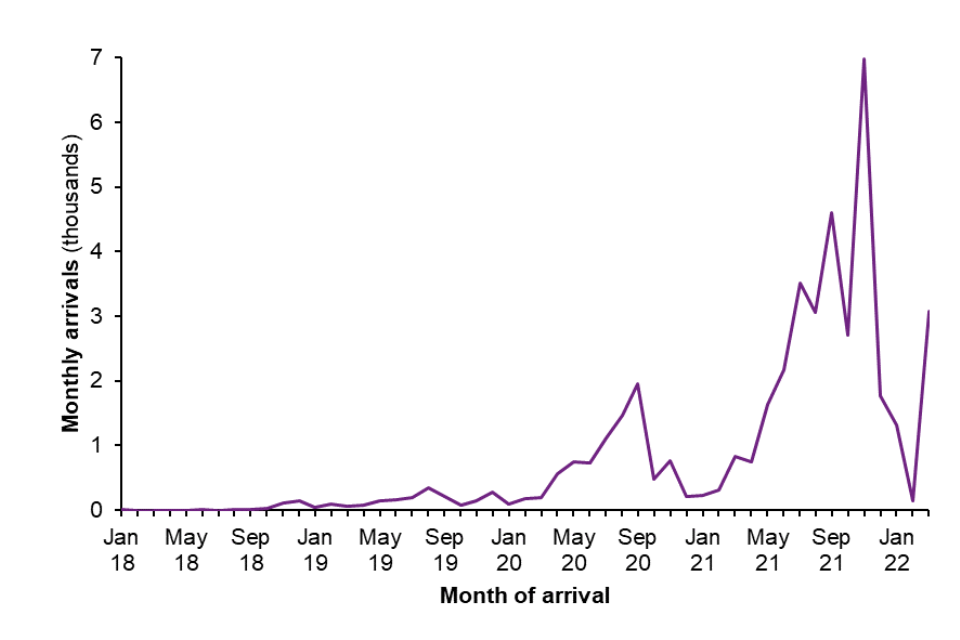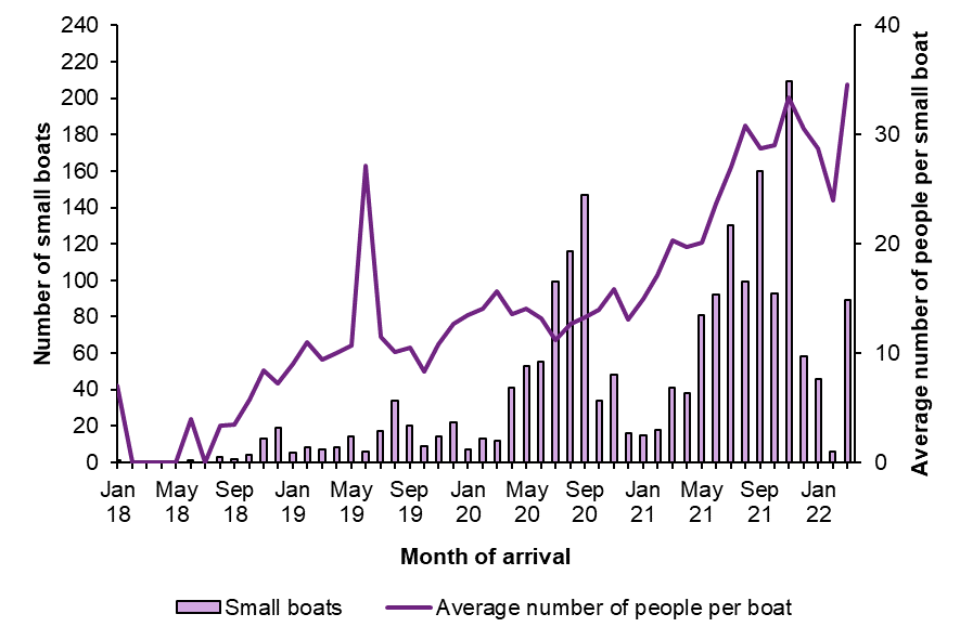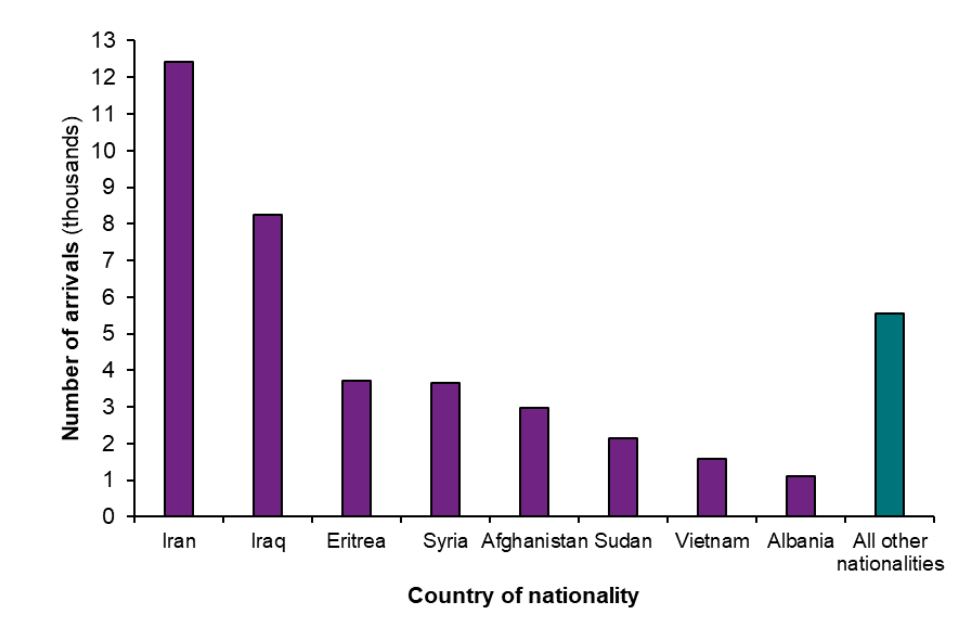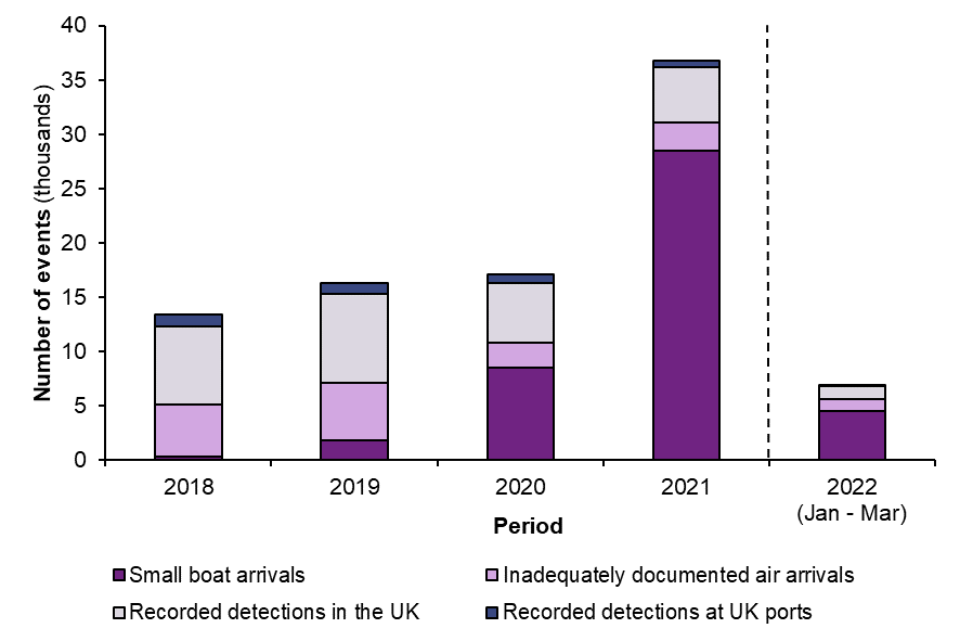Irregular migration to the UK, year ending March 2022
Published 26 May 2022
This is not the latest release. View latest release.
Introduction
This release provides an overview of irregular migrants who come to the UK, including those arriving on a small boat across the English Channel (a ‘small boat arrival’), a phenomenon that was rare prior to 2019 but has since increased sharply in number.
The statistics presented here relate to the number of people recorded being detected on, or shortly after, arrival to the UK on various routes (flow). They do not provide an indication of the total number of people currently in the UK who have entered the UK via irregular routes (stock).
It is not possible to know the exact size of the irregular population in the UK, nor the total number of people who enter the UK irregularly and a small boat is only one of a number of irregular methods by which a person may reach the UK border and seek entry without permission. This report provides additional statistics on irregular modes of entry but we are not able to report on all methods of irregular entry into the UK or provide an estimate for the entirety of the irregular migrant population. Some people may enter the UK on regular routes and their status subsequently become irregular (for example if they overstay their visa). Others may enter through a clandestine method and remain undetected or will be detected some time after their arrival. Additionally, other migrants may enter irregularly but gain ‘regular’ status (for example following an application for asylum).
Other migrants may seek to enter the UK without valid permission but be prevented from reaching the UK border (for example, at the juxtaposed controls in France and Belgium, or further afield, if prevented from travelling for example). Any counts of these attempted entries will relate to the number of recorded detections, which may include multiple attempts by the same individual, and therefore do not relate to numbers of persons.
Additional information is provided in the ‘about the statistics’ section.
How many migrants were detected arriving in the UK via small boats?
Statistics on small boats include individuals who are detected on arrival to the UK, detected in the Channel and subsequently brought to the UK, and those encountered in the UK who are suspected of having arrived on a small boat. They do not include any persons arriving on larger vessels (such as on a ferry), those prevented from departing France or intercepted by French authorities and returned to France, or those who arrive in the UK undetected (see the ‘about the statistics’ section for more details).
There were 4,540 people detected arriving by small boats in January to March 2022. This is more than three times higher than the same three months in 2021 (1,363).
There were 28,526 people detected arriving on small boats in the calendar year 2021. This compares with 8,466 in 2020, 1,843 in 2019 and 299 in 2018.
The month of November 2021, saw the highest number of small boat arrivals of any month in the last four years (6,971). The number of arrivals in each month of 2021 were higher than in the comparable months in 2020. In 2020, arrivals were higher over the summer and peaked in September, reflecting seasonal weather patterns. In 2021, arrivals similarly increased over the summer months to September, but also rose sharply in the Autumn, peaking in November.
Figure 1 - Number of people detected arriving in the UK via small boats, January 2018 to March 2022

Source: Irregular Migration to the UK data tables - Irr_02a
There were 141 small boats detected arriving in the UK in January to March 2022 (each boat contains multiple people). This is just under double the number of small boats detected in the same three months in 2021 (74).
There were 1,034 small boats detected arriving in the UK in the calendar year 2021. This compares with 641 in 2020, 164 in 2019 and 43 in 2018. The yearly increase in the number of people arriving is related to both more boats making the crossing and an increase in the average number of people on each boat. In 2021, there were an average of 28 people per small boat, which was much higher than 2020 (13 people per small boat), 2019 (11 people) and 2018 (7 people). There has been an average of 32 people per small boat in the first three months of 2022.
Figure 2 – Number of small boats and average number of people per boat detected arriving in the UK, January 2018 to March 2022

Source: Irregular Migration to the UK data tables - Irr_02a
In January to March 2022, there was one or more small boat recorded arriving on one-third of the days (30 of the 90 days).
In the calendar year 2021, at least one small boat crossing occurred on 154 out of 365 days (around 2 in every 5). This compares to 130 in 2020, 81 in 2019 and 29 in 2018.
In January to March 2022, over half (55%) of small boat arrivals were from Afghan (24%), Iranian (16%) and Iraqi (15%) nationals.
Since January 2018, Iranian (30%) and Iraqi (20%) nationals represent half of all small boat arrivals. Iranians represented the vast majority of small boat arrivals in 2018 (80%) and 2019 (66%). However, a greater mix of nationalities have been detected making the crossing since 2020 (see table Irr_02b).
Figure 3 – Number of small boat arrivals by nationality, January 2018 to March 2022

Source: Irregular Migration to the UK data tables - Irr_02b
Notes:
- The chart shows nationalities with at least 1,000 small boat arrivals since January 2018, ordered by most to fewest.
- The chart does not include arrivals where information on nationality was not yet available in the dataset.
Overall, males represented approximately 9 out of 10 (89%) small boat arrivals in January to March 2022, which is the same as the average between calendar years 2018 to 2021.
Since January 2018, almost three-quarters (72%) of arrivals were adult males aged 18 to 39, compared to 6% for females in the same age bracket. Of the remaining arrivals, 14% were children under the age of 18 and 7% were adults aged 40 and over (see table Irr_02c).
Other irregular routes
Data in this section are derived from Home Office Management Information. The data are not designed for statistical purposes and therefore, should be interpreted with caution. Further information is found in the ‘about the statistics’ section.
As set out in the introduction, it is not possible to directly compare recorded detections on different methods of entry, or add these together to provide a full picture of how many migrants are entering the UK without permission. However, some broad trends can be observed.
While there was an initial increase in small boats detections in 2019, recorded detections on other routes remained relatively stable. As small boat arrivals increased further in 2020, detections on other routes declined. This is likely in part due to the Covid-19 pandemic making these methods of entry less viable. However, in the most recent data, there continues to be an increase in the numbers of small boat arrivals, despite some of the other entry methods becoming more viable as Covid-19 restrictions globally begin to ease.
Figure 4 – Detections at the UK border, by method of entry, 2018 to 2021, and Q1 (January to March) 2022

Source: Irregular Migration to the UK data tables - Irr_01
Notes:
- The chart should not be used to interpret the total number of detected arrivals, nor to compare the different modes of arrivals. Different datasets have different levels of coverage which means they are not comparable. Further details and definitions of each category are provided in the ‘about the statistics’ section.
- The data includes the number of people recorded as attempting to enter the UK, having been detected on, or within 72 hours of, arrival to the UK. They do not include those prevented from reaching the UK border (for example, those prevented from boarding transportation at their port of embarkation or where their concealment in a vehicle has been detected prior to arrival in the UK).
About the statistics
These statistics should not be used to infer the size of the irregular population in the UK, nor the total number of people entering the UK irregularly. For a number of reasons, it is not possible to know the exact size of the irregular population, or the number entering irregularly, and so we have not produced any official estimates for this number.
This is because:
- some irregular migrants will successfully evade border controls and remain in the UK undetected
- some migrants who enter the UK regularly may subsequently become ‘irregular’ migrants – for example if they overstay a visa (it should be noted that there are a number of ways in which a migrant’s departure from the UK may legitimately not be recorded on the system)
- the data sources available count the number of recorded detections - in some instances the same person may be detected multiple times, either on the same route or across different routes (such individuals will be counted multiple times in the statistics)
- some migrants who enter the UK irregularly may subsequently become ‘regular’ migrants – for example following a successful asylum application
Figures on detections will be impacted by operational activity at the border and overseas, so should not be used to infer levels of irregular migration. Changes in detection could be a result of changes in operational activity as well as changes in the number of people attempting to enter the UK irregularly and recording practices.
Small boats
A ‘small boat’ is one of a number of vessels used by individuals who cross the English Channel, with the aim of gaining entry to the UK without a visa or permission to enter – either directly by landing in the UK or having been intercepted at sea by the authorities and brought ashore. The most common small vessels detected making these types of crossings are rigid-hulled inflatable boats (RHIBs), dinghies and kayaks.
The statistics in this release include individuals who:
- are detected on arrival in the UK
- are detected in the Channel by UK authorities and subsequently brought to the UK
These statistics do not include individuals who:
- arrive on larger vessels, such as go-fast craft, yachts, motor cruisers, tugs and fishing vessels – although these are rarely used by irregular migrants at present
- arrive in the UK clandestinely on larger vessels not referenced above, including where hidden in a vehicle on a ferry
- are prevented from departing France, or those intercepted by French authorities and returned to France
- arrive in the UK undetected, or where there have been reports of people making the crossing, but no actual encounters
In some instances, particularly during periods of high numbers of arrivals, it can take some time for the full information from an asylum claim to be checked and recorded on case working systems. Data on the total number of small boat arrivals (from 2021 onwards) are derived from manual records collated by Border Force officers. More detailed breakdowns (e.g. nationality, sex and age) are derived from case working systems, including the asylum application, which take longer to complete. As a result, data for some periods, particularly more recent periods, may have a number of cases where a full breakdown is not yet available.
On 14 April 2022, the Government announced that the Ministry of Defence (MoD) would take operational command of responding to small boat crossings. The MoD began publishing provisional daily and weekly numbers on ‘Migrants detected crossing the English Channel in small boats’, from April 2022. This is after the coverage of this Irregular Migration report. The MoD operational data may differ from future Home Office published figures due to the data being derived from the operational records available on arrival. Figures in this report are produced later to allow more time for additional information to be recorded and additional quality assurance to be undertaken.
Other entry methods
This report also refers to some other modes of irregular entry. Data in these sections are derived from Home Office Management Information. The data are not designed for statistical purposes and therefore, should be interpreted with caution.
Each dataset will be subject to a number of unknowns, for example an unknown number of people will evade detection altogether. Additionally, there will be instances where a detection may not be recorded on the system. The extent of these will vary between datasets and as such, it is not possible to compare different datasets, or infer the total number of people attempting to enter irregularly on each route.
Data on inadequately documented air arrivals relate to individuals who intentionally attempt to arrive in the UK via air routes either without adequate documentation or using fraudulent documentation. This does not include passengers who have genuinely made a mistake, lost their documents, or have arrived inadequately documented for reasons outside of their control. It does not include those who were prevented from boarding at their port of embarkation.
Data on recorded detections in the UK relate to detections of individuals outside of the controlled environment of a port, who when encountered are believed by authorities to have evaded border controls to enter the UK clandestinely, up to 72 hours before being detected. This includes detections at the ports serviced by the juxtaposed controls (Dover, Cheriton/Longport and St Pancras).
Data on recorded UK port detections include individuals attempting to enter the UK clandestinely at ports. This includes, for example, those detected at ports in lorries, and shipping containers. It does not include detections at ports that are serviced by the juxtaposed controls or those prevented from leaving their port of embarkation on route to the UK, such as those detected at the juxtaposed controls.
